
CHAMPIONS League GROUP STAGE, NOVEMBER 4 2025
Mac Allister (61)
Liverpool beat Real Madrid at Anfield for the second successive season courtesy of this well-earned victory. As with their Champions League meeting 12 months ago, Alexis Mac Allister was on the scoresheet; this time meeting a Dominik Szoboszlai free-kick to power a header past Thibaut Courtois. Until that point the Real Madrid goalkeeper had looked virtually unbeatable, producing save after save to keep his team in the game. Unfortunately for the Belgian, his teammates were unable to produce enough with the ball to take something from the game. They live to fight another day, however, sat just ahead of Liverpool in the top eight of the initial league phase.
How the managers saw it
“I told the players today that I wanted them to either press really high or go to a low block,” said Arne Slot, “because Vinícius and [Kylian] Mbappé are for so many reasons incredible players. But their deep runs, timing of deep runs, their pace is next level. So don’t give away any space in behind and that’s what our last line did very well tonight.
“Apart from everything we can say, we beat them because of a set-piece. It’s nicer to talk about this if you win because if you lose, people come up with that I try to find excuses. But a positive set-piece balance is the minimum you need to get a result nine out of 10 times, and that’s what we had today.”
“It was a demanding game, really fast-paced,” said Xabi Alonso. “We competed well but we lacked a real threat. The first half was fairly evenly matched and the second was decided by small margins. We started giving away too many free-kicks and the odd corner. Courtois kept us in it there. The goal gave them the edge and then we struggled a bit after that.
“We have to learn that when they put the pressure on, which can happen when the crowd get up for it, we have to avoid giving away corners and free-kicks. We needed to create more opportunities. It was an intense game. We gave away a little bit too much at the start of the second half, we gifted them too many chances. It was avoidable. We should have been higher up, and they have great free-kick takers and finishers. They created a lot of chances because we gave away too many fouls.”
 252645121038781122183241814685710
25264512103878112218324181468571017/9
SHOTS / ON TARGET
8/2
39%
POSSESSION
61%
24
ATTACKS INTO AREA
23
2.28
EXPECTED GOALS (XG)
0.32
Wirtz moving inside
From Liverpool’s initial 4-2-3-1 shape, Florian Wirtz moved inside from the left wing. This made space for Andy Robertson to advance from full-back and create width on the left. Wirtz’s positioning also connected him with the rest of Liverpool’s midfield, overloading Real Madrid’s central midfield pair. Alonso’s team defended in a 4-4-2, with Jude Bellingham joining Mbappé in the first line. Liverpool’s numbers in midfield meant one of their midfielders (Mac Allister, below) could drop to cover when Robertson advanced, as well as helping the centre-backs to build through or around Madrid’s first line.
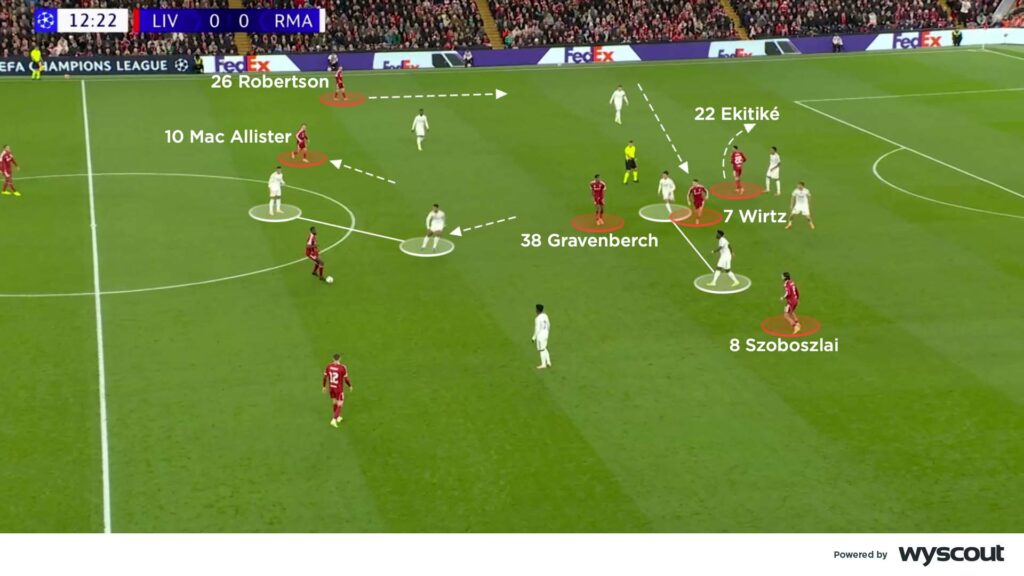
Robertson and Mohamed Salah continued to hold the width for Liverpool in the first half, providing runs in behind for direct passes over Madrid’s back line. Although they didn’t always receive a pass, by making these runs they stretched the opposition back line across the pitch, creating gaps for Liverpool’s central players to receive in. Liverpool continued to drop a midfielder out of the central spaces once Wirtz had moved inside. The German midfielder’s movement worked to pull Dean Huijsen out of Madrid’s back line, which helped Liverpool to exploit centrally. Forward Hugo Ekitiké bent his runs outwards and looked to work on the blindside of Militão, complimenting the movements of Wirtz (below).
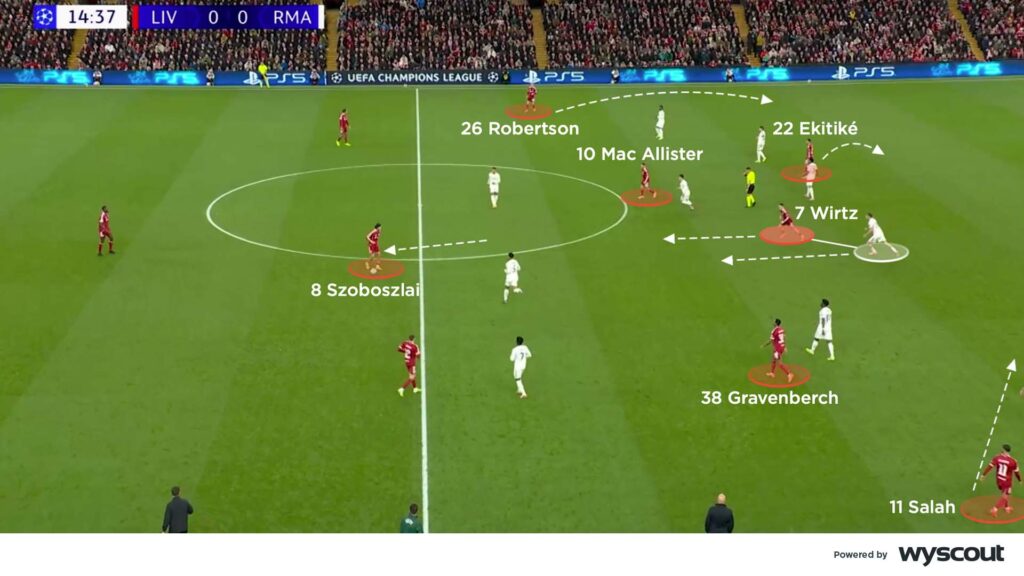
A Madrid player – mostly from the wide areas – occasionally jumped to press Liverpool’s midfield three. But Ryan Gravenberch, Mac Allister and Szoboszlai were excellent at recognising when to speed the game up, and then find their spare wide player. That was mostly Conor Bradley, as a result of Vinícius jumping, Salah stretching high and Wirtz continuing to move across. From here, Liverpool could find Wirtz and Ekitiké against the two Madrid centre-backs, with Salah adding a consistent threat beyond (below). The home side had a big opportunity to open the scoring before the break, when Wirtz latched on to a loose ball and broke to cross for Szoboszlai, only for Courtois to make an outstanding 1v1 save.
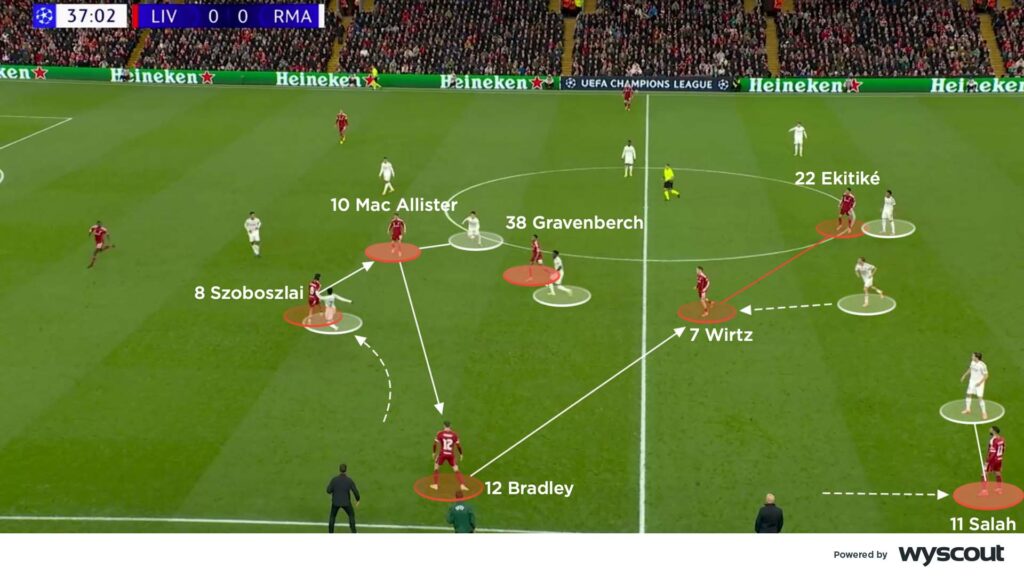
Liverpool placed more numbers between the lines in the second half, especially with Madrid trying to be more compact ahead of their back line. The visitors’ midfield unit tried to drop further, while Mbappé and Bellingham were also more withdrawn with their defensive positioning. Liverpool pushed Bradley higher at times as Wirtz continued to narrow from the left (below). Some Liverpool combinations on the right worked well to break the second line, but they were mostly in front of Madrid’s back four as the home side rarely managed to penetrate a second time in behind. Indeed, for the majority of the game they were reduced to efforts from range. Madrid’s fouling also stopped their momentum, but led to the goal from a set piece after Liverpool had again broken through the opposition midfield.
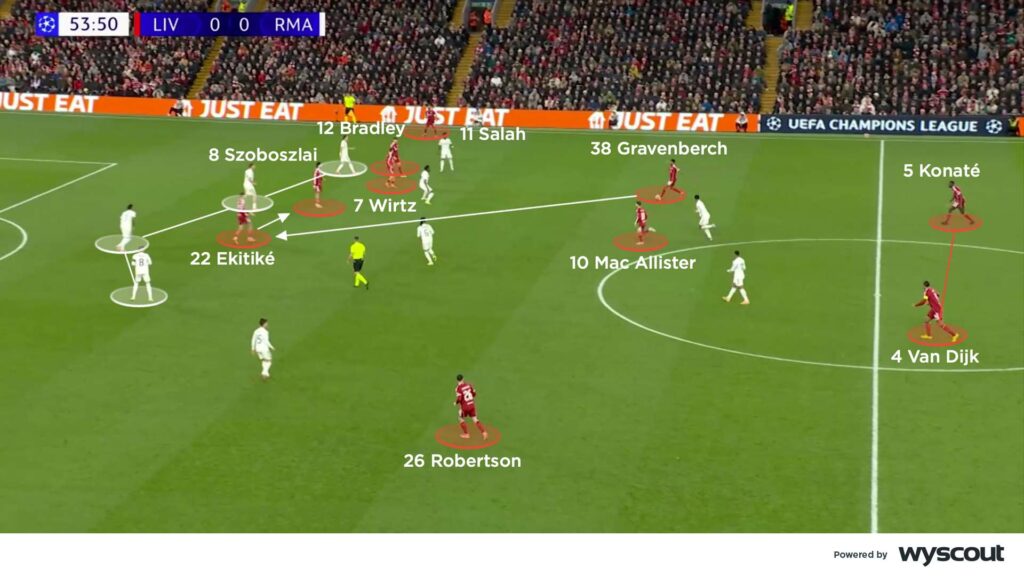
Madrid’s left
From their 4-2-3-1, Madrid looked to combine on their left side. Number 10 Bellingham moved across to support Vinícius. Left-back Álvaro Carreras joined from deep, but only when an obvious 2v1 moment appeared against Bradley, who was locked in an aggressive battle with Vinícius for most of the game. Mbappé as the main central forward threat drifted into the left inside channel and supported combinations there. Madrid’s double pivot and centre-backs built underneath, but Alonso}s team were very one sided. Eduardo Camavinga was used on the right with Federico Valverde (below), but neither were able to exploit or create around Robertson.

In moments where one of Liverpool’s midfielders jumped to press, Madrid did progress and had some moments of potential. Aurélien Tchouaméni and Arda Güler adjusted and supported well to create a passing link between the back line and those working the left side. From the back, Dean Huijsen’s forward passes and carries into midfield were a particular outlet. From here, players on Madrid’s left side managed to receive on the shoulders or just beyond Liverpool’s midfielders (below). But they struggled to create as they slowed the play down too much, lacking directness at times. They also came up against a resolute Liverpool back four, as well as impressive recovery runs from opponents initially beyond the ball.
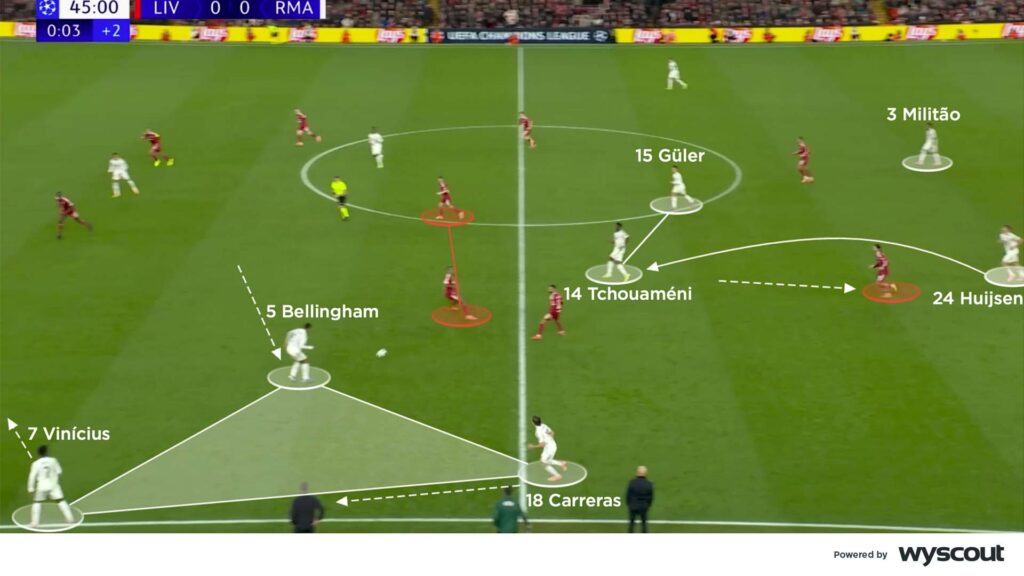
Alonso added Rodrygo to Madrid’s attack in the second half, with Güler swapping roles with the substituted Camavinga. But Liverpool’s deep defending remained organised and solid, and Madrid’s right-side created very little. Madrid’s numbers on the left continued to help them progress play, but Liverpool’s midfield three – narrow and compact ahead of the back four – were able to shuffle across to defend. In some cases one of Slot’s full-backs pressed outward, with a midfielder providing solid cover inside. Liverpool’s front line also did a good job of helping to lock the play one way. The result was that, although Madrid had a few moments from the left, they couldn’t break down the home side’s 4-3-3 low block (below), with periods of sideways possession rarely testing or threatening Liverpool.
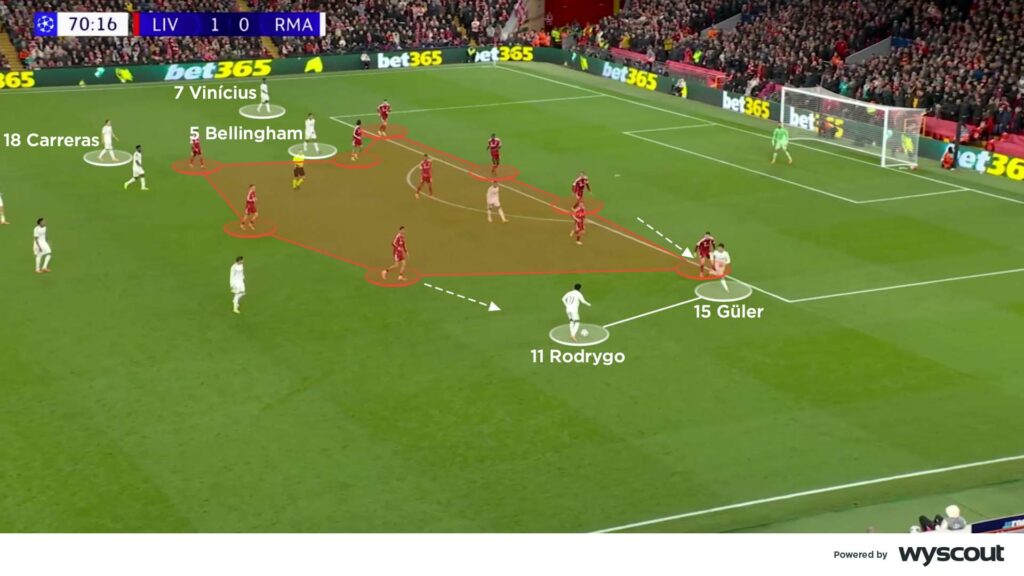
Having gone 10 games without keeping a clean sheet before last weekend, Liverpool’s second shutout in three days earned them a much-needed win. The result was a disappointment for Real Madrid, meanwhile, having won 13 of their first 14 games in La Liga and the Champions League this season. It remains a very promising start for head coach Xabi Alonso, who will now focus on the challenge of Rayo Vallecano in the next game. Liverpool, meanwhile, face another big test of their credentials when they visit Manchester City in the Premier League.
To learn more about football tactics and gain insights from coaches at the top of the game, visit CV Academy


